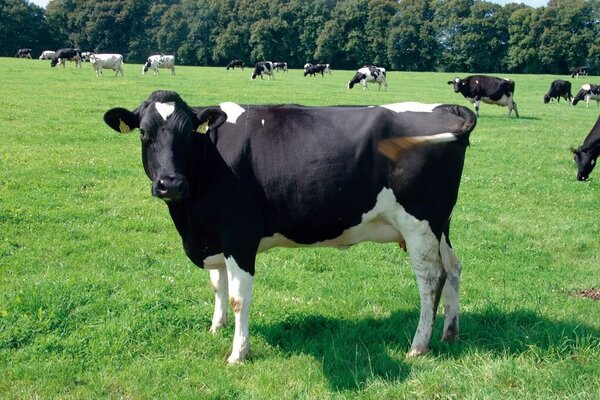Facts & Figures
Emissions of greenhouse gases from agriculture
Roland Fuß, Cora Vos, Claus Rösemann | 15.03.2024
In 2022, German agriculture was responsible for the emission of about 53.3 million tons of carbon dioxide equivalents. This corresponds to 7.1% of the greenhouse gas emissions in Germany. Main sources are emissions of methane from animal husbandry and nitrous oxide from agricultural soils.
The share of nitrous oxide (N2O) from soils (including emissions due to spreading of digestate from energy crops) was 26.7 %, whereas the share of methane (CH4) from enteric fermentation was 48.9 %. The remaining 24.5 % of the emissions from agriculture came from manure management, storage of digestate from energy crops, liming and the application of urea.
Emissions of N2O from manure management as well as emissions of CH4 from enteric fermentation and manure management have decreased significantly since 1990. In 2022, the emissions of N2O were lower than those in 1990 by about 28.6 %, and the CH4 emissions by about 29.0 %.
94 to 95 % of the overall emissions of CH4 and N2O from livestock originate from digestion and manure management (stable, storage) of cattle and pigs, 2 to 3 % from other animals (mainly poultry, sheep, goats and horses). These figures are largely constant over the years (2022: dairy cows 51.8 %, other cattle 34.3 %, pigs 8.9 %, other animals 3.1 %). The remainder of the overall emissions (2022: 2.0 %) are N2O emissions resulting from soil after deposition of nitrogen previously emitted as NH3 and NO from all stables and manure stores.
The decline in emissions compared to 1990 results mainly from the structural change at the beginning of the 1990s, which led to a decrease in cattle numbers until the mid-2000s. Since the 2010s, a further decline in livestock numbers and, since 2015, a decline in the amount of synthetic fertiliser applied have also led to a renewed reduction in emissions.
Other reasons for the decline in emissions are the increasing importance of anaerobic fermentation of farm manure in biogas plants and the partially gas-tight storage of fermentation residues. The use of renewable raw materials in biogas plants, on the other hand, leads to additional CH4 emissions from the plant and the storage of fermentation residues.
Since a low in 2006, greenhouse gas emissions in the agriculture sector have initially increased again, only to fall again from 2015 and reach new lows from 2019. Compared to the previous year 2021, emissions in 2022 have fallen by around 1.8 %. This is primarily due to the further decline in cattle and pig numbers and the reduction in the quantities of synthetic fertilisers applied.
The Climate Protection Act defines a reduction path for greenhouse gas emissions for each emission sector, the exceeding of which results in immediate measures in the respective sector. The law stipulates that only 56 million tonnes of CO2 equivalents may be emitted in the agricultural sector by 2030. The reduction path was adjusted (due to credits from previous undercutting of the reduction path) and the target value for 2030 is currently 58.4 million tonnes of CO2 equivalents.
The sector "agriculture" of the Climate Protection Act is not completely congruent with the sector of the same name in the emissions reporting: Emissions from fuel use in agriculture, forestry and fisheries, which are calculated by the Umweltbundesamt (Federal Environment Agency), are added. The remaining agricultural emissions are determined by the Thünen Institute using the methods of emissions reporting.
Compliance with the reduction path is checked using the so-called previous year's estimate, which is partly based on provisional data. This year's previous year's estimate for 2023 results in total agricultural greenhouse gas emissions of 60.3 million tonnes of CO2 equivalents (52.2 million tonnes of agriculture in the narrower sense plus 8.1 million tonnes of fuel consumption) and is below the 67.4 million tonnes of CO2 equivalents permitted under the reduction path. Compared to the emissions for 2022, this means a decrease, which is mainly due to lower cattle numbers and lower sales of synthetic fertilisers.
Compliance with the reduction path will become a considerable challenge in the coming years, which must be met with the measures of the climate protection programme.
In contrast to ammonia emissions, there are so far few technical options for mitigation measures for methane and nitrous oxide emissions beyond restricting agricultural production. The greatest reduction potential is
- low-emission fertilisation geared to plant requirements, which avoids nitrogen surpluses and thus nitrous oxide emissions from agriculturally used soils,
- feeding animals in a way that is optimised in terms of crude protein use and methane formation,
- the fermentation of animal excrement in biogas plants and the subsequent gas-tight storage of the fermentation residues.
CO2 emissions from fuel consumption can be reduced by improving energy efficiency and switching to renewable energy.
As a result of enhanced performance, emissions per animal increase. For example, in recent years, despite the decreasing number of dairy cows, there has often been an increase in total emissions from dairy cows. This is due to the constant increase in average milk yield.
In terms of products, however, the increasing milk yield leads to a decrease in emissions per kilogram of milk. This is due to the fact that the maintenance energy requirement of a dairy cow is independent of milk yield and therefore does not increase with rising milk yields. A basically similar picture emerges for the performance-related greenhouse gas emissions from fattening pig farming.
However, an absolute greenhouse gas reduction results from these intensification effects only if absolute production does not increase, i.e. if the number of animals decreases.
More information:
- Calculations of gaseous and particular emissions from German agriculture 1990–2022: Report on methods and data (RMD) Berichterstattung 2024.
- The file belonging to the report with input data and emission results.
- New: county-by-county emissions of green house gases.
All available at https://www.eminv-agriculture.de/.


![[Translate to English:] Logo des Bundesministerium für Ernährung und Landwirtschaft](/media/allgemein/logos/BMEL_Logo.svg)